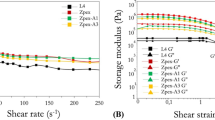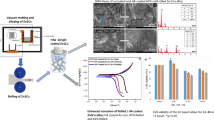Abstract
Premixed calcium phosphate cements (pCPC) have been developed to circumvent problems related to mixing and transfer of cements in the operating room. In addition, by using pCPC the short working times generally associated with conventional water-mixed cements are avoided. In this work, the influence of particle size on handling and hardening characteristics of a premixed monetite cement has been assessed. The cements were evaluated with respect to their injectability, setting time and compressive strength. It was found that cements with smaller particle sizes were more difficult to inject and had higher compressive strength. Regarding setting time, no clear trend could be discerned. The addition of granules made the cements easier to inject, but setting time was prolonged and lower strengths were obtained. The main findings of this work demonstrate that particle size can be used to control handling and physical properties of premixed cements and that previous knowledge from water-based CPC, regarding effects of particle size, is not directly applicable to premixed CPC.






Similar content being viewed by others
References
Legeros R, Chohayeb A, Shulman A. Apatitic calcium phosphates: possible dental restorative materials. J Dent Res. 1982;61:343.
Brown W, Chow LC. A new calcium phosphate setting cement. J Dent Res. 1983;62:672.
Larsson S. Calcium phosphates: what is the evidence? J Orthop Trauma. 2010;24:S41–5.
Ryf C, Goldhahn S, Radziejowski M, Blauth M, Hanson B. A new injectable brushite cement: first results in distal radius and proximal tibia fractures. Eur J Trauma Emerg Surg. 2009;35(4):389–96.
Lee DW, Kim JY, Lew DH. Use of rapidly hardening hydroxyapatite cement for facial contouring surgery. J Craniofac Surg. 2010;21(4):1084–8. doi:10.1097/Scs.0b013e3181e1b64b.
Wolff KD, Swaid S, Nolte D, Bockmann RA, Holzle F, Muller-Mai C. Degradable injectable bone cement in maxillofacial surgery: indications and clinical experience in 27 patients. J Craniomaxillofac Surg. 2004;32(2):71–9. doi:10.1016/S1010-5182(03)00134-3.
Dorozhkin SV. Calcium orthophosphate cements for biomedical application. J Mater Sci. 2008;43(9):3028–57.
Bohner M, van Landuyt P, Merkle HP, Lemaitre J. Composition effects on the pH of a hydraulic calcium phosphate cement. J Mater Sci Mater Med. 1997;8(11):675–81.
Åberg J, Brisby H, Henriksson HB, Lindahl A, Thomsen P, Engqvist H. Premixed acidic calcium phosphate cement: characterization of strength and microstructure. J Biomed Mater Res B Appl Biomater. 2010;93B(2):436–41.
Liu CS, Shen W, Gu YF, Hu LM. Mechanism of the hardening process for a hydroxyapatite cement. J Biomed Mater Res. 1997;35(1):75–80.
Sugawara A, Chow LC, Takagi S, Chohayeb H. In vitro evaluation of the sealing ability of a calcium-phosphate cement when used as a root-canal sealer-filler. J Endod. 1990;16(4):162–5.
Takagi S, Chow LC, Hirayama S, Sugawara A. Premixed calcium-phosphate cement pastes. J Biomed Mater Res B Appl Biomater. 2003;67B(2):689–96.
Carey LE, Xu HHK, Simon CG, Takagi S, Chow LC. Premixed rapid-setting calcium phosphate composites for bone repair. Biomaterials. 2005;26(24):5002–14.
Han B, Ma PW, Zhang LL, Yin YJ, Yao KD, Zhang FJ, et al. beta-TCP/MCPM-based premixed calcium phosphate cements. Acta Biomater. 2009;5(8):3165–77. doi:10.1016/j.actbio.2009.04.024.
Bohner M, Baroud G. Injectability of calcium phosphate pastes. Biomaterials. 2005;26(13):1553–63.
Andrianjatovo H, Jose F, LeMaitre J. Effect of beta-TCP granularity on setting time and strength of calcium phosphate hydraulic cements. J Mater Sci Mater Med. 1996;7(1):34–9.
Ohura K, Bohner M, Hardouin P, Lemaitre J, Pasquier G, Flautre B. Resorption of, and bone formation from, new beta-tricalcium phosphate-monocalcium phosphate cements: an in vivo study. J Biomed Mater Res. 1996;30(2):193–200.
Underwood E. Quantitative stereology. Reading: Addison-Wesly; 1970.
Ishikawa K. Calcium phosphate cement. In: Kokubo T, editor. Bioceramics and their clinical applications. Cambridge: Woodhead publishing limited; 2008.
Ginebra MP, del Valle S, Mino N, Munoz F, Gonzalez A, Planell JA. In vivo evaluation of an injectable macroporous calcium phosphate cement. J Mater Sci Mater Med. 2007;18(2):353–61.
Gbureck U, Dembski S, Thull R, Barralet JE. Factors influencing calcium phosphate cement shelf-life. Biomaterials. 2005;26(17):3691–7.
Engstrand J, Aberg J, Engqvist H. Influence of water content on hardening and handling of a premixed calcium phosphate cement. Mater Sci Eng C. 2013;33(1):527–31. doi:10.1016/j.msec.2012.09.026.
Rajzer I, Castano O, Engel E, Planell JA. Injectable and fast resorbable calcium phosphate cement for body-setting bone grafts. J Mater Sci Mater Med. 2010;21(7):2049–56.
Acknowledgments
The Swedish Research Council and the FP7 NMP project Biodesign are gratefully acknowledged for financial support.
Author information
Authors and Affiliations
Corresponding author
Rights and permissions
About this article
Cite this article
Åberg, J., Engstrand, J. & Engqvist, H. Influence of particle size on hardening and handling of a premixed calcium phosphate cement. J Mater Sci: Mater Med 24, 829–835 (2013). https://doi.org/10.1007/s10856-013-4855-z
Received:
Accepted:
Published:
Issue Date:
DOI: https://doi.org/10.1007/s10856-013-4855-z




